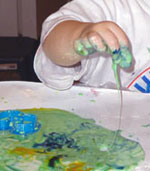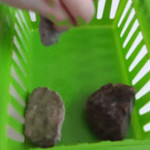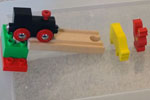E is for Experiment
The letter E is up next in the A to Z Science series for toddlers and preschoolers here at Inspiration Laboratories. E is for Experiment.

What Does Experiment Mean?
I find it interesting that experiment is both a noun and a verb. You can do an experiment {noun}, and you can experiment {verb}. In an experiment, you change things in an organized way and observe what happens. Experimenting is all about cause and effect. If I do this, then this will happen.
Investigation or Experiment?
Investigation goes hand in hand with experimenting. Observations are needed for both. The words seem to be used interchangeably, but should they be? A scientific investigation implies trying to figure something out by studying it. You can investigate the migration patterns of birds. Observing the behavior of your dog could be an investigation. An experiment, on the other hand, requires manipulation. Something has to be changed. An experiment involves testing ideas. During an investigation, experiments can be performed. If you are investigating ramps, you could create an experiment varying the height of the ramps. In the end does it really matter what words you use? I doubt it. I tend to use the words investigation and exploration when dealing with toddlers and preschoolers just because we don’t typically do full out experiments with them. That doesn’t mean you can’t. I’m going to show you a few ways you can turn your investigations and explorations into experiments.
Experiments for Toddlers and Preschoolers
 |
Cornstarch & Water – Everyone loves playing with this messy goo, goop, oobleck, or whatever you call it. For this one, simply allow your child to figure out how to make the “right” consistency. Varying the amounts of cornstarch and water will produce different consistencies {viscosities}. This post gives you the science behind it and some additional questions to ask. |
 |
Baking Soda & Vinegar – Another classic kid combo that has great potential for experimenting. The key again is to change something. Change the amount of baking soda or the amount of vinegar. Add something else to the reaction and see if that impacts anything. We added soap in the B is for Baking Soda & Vinegar and BUBBLES post of the A to Z Science series. |
 |
Comparisons – Use a question to guide the experiment and then run tests to find the answer. Which weighs more? Which is more dense? What objects float in water? Who is faster? Try this density exploration. |
 |
Ramps and Chain Reactions – There are a lot of things you could change here. You can vary the height of the ramp. You could change the length of the ramp. You could change the objects going down the ramp {their shape, size, weight}. You could change what is at the bottom of the ramp. Don’t forget about the surface of the ramp – is it wood, metal, plastic, sandpaper, etc.? This post shows you how my son {then age 2} and I explored cause and effect using ramps. |
For more toddler and preschool science experiments, check out this collection from around the web.
What are your favorites?
Don’t miss the rest of the A to Z Science series! Connect with Inspiration Laboratories on Twitter, Google+, Pinterest, or Facebook . You can also subscribe to posts by e-mail.
Linking up here.

Leave a Reply